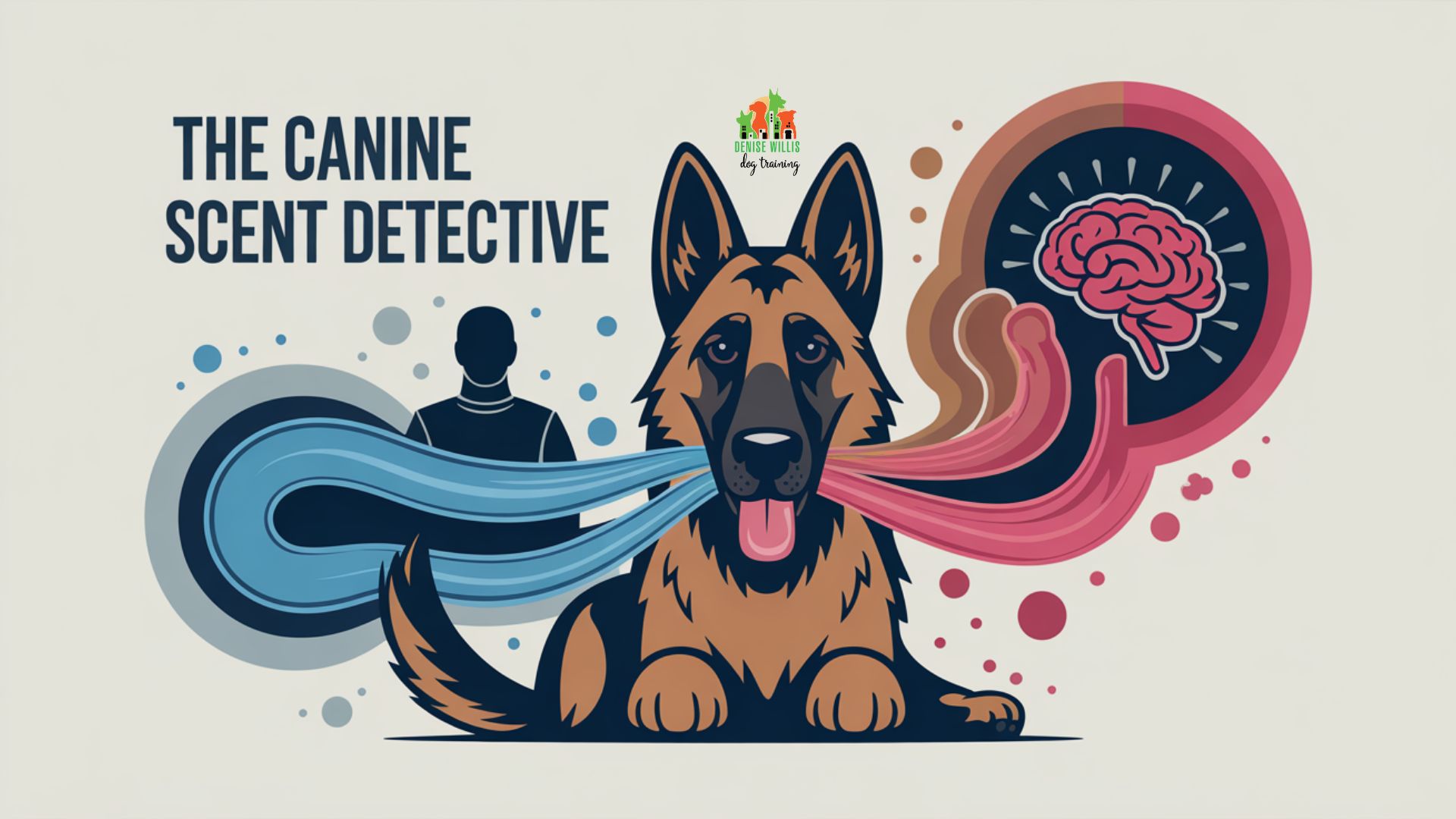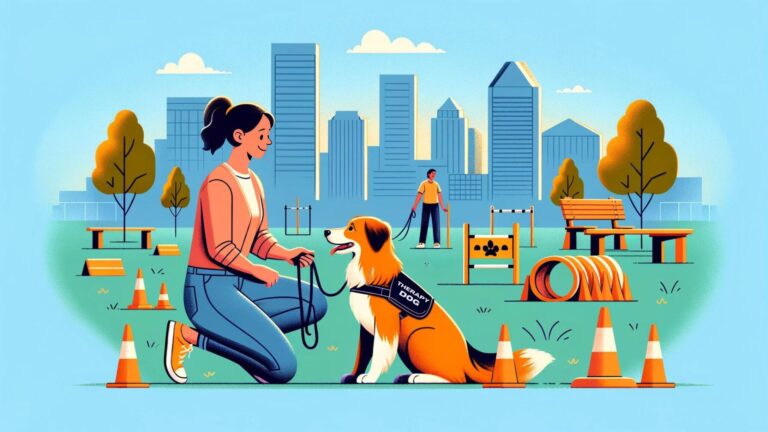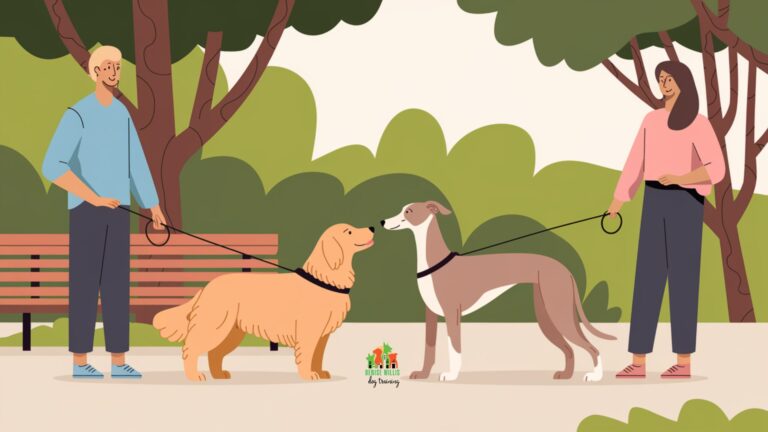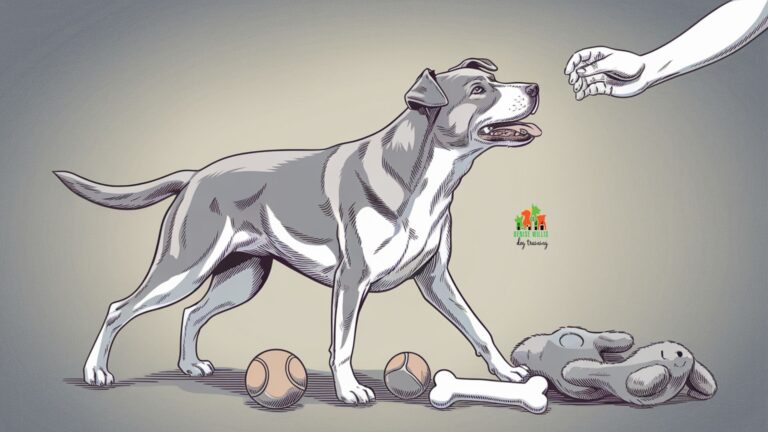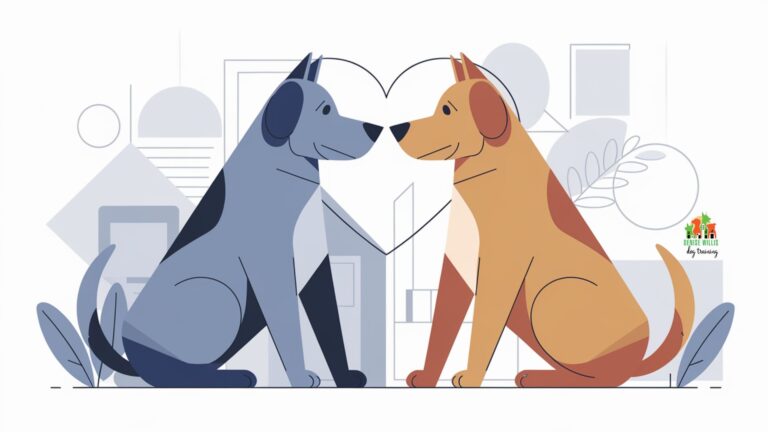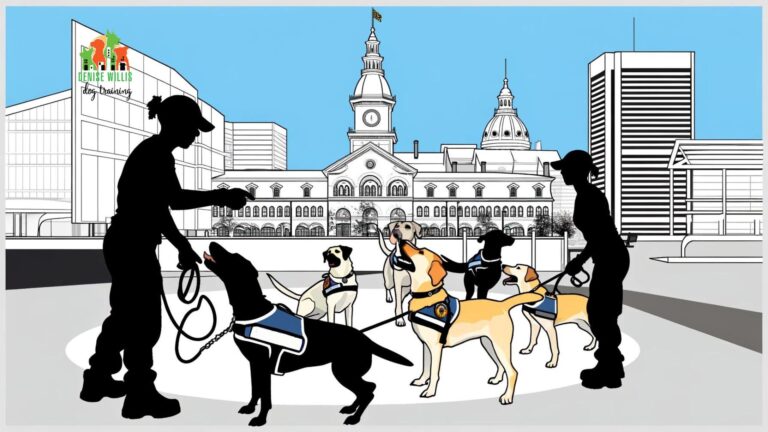The Smell of Trouble: Understanding Scent Triggers in Dog Aggression
📍 Service Area Notice: DW Dog Training provides in-person training services exclusively in the Greater Baltimore area. While our blog content is designed to help dog owners internationally, our hands-on training services are locally focused. For readers outside our service area, we hope you find value in our articles and welcome you to reach out with questions!
Have you ever watched your normally sweet pup transform into a growling, lunging mess at seemingly nothing, only to realize later they were reacting to something you couldn’t even detect?
Welcome to the invisible world of scent-triggered aggression. Your dog is basically responding to ghost smells that you’re completely oblivious to. Dogs experience their world nose-first, with olfactory capabilities that make our human schnozzes look positively primitive. And sometimes, what they’re smelling is sending all sorts of alarm bells ringing in their doggy brains.
When your canine companion suddenly goes from Dr. Jekyll to Mr. Hyde, those mysterious scent triggers might be the culprit behind this dramatic personality shift. Understanding this connection between smell and aggression isn’t just fascinating science, it’s the key to helping your reactive rover become a more balanced buddy.
Key Takeaways
- Dogs possess an extraordinary olfactory system with 225-300 million receptors (compared to 6-10 million in humans), making their sense of smell thousands of times more acute than ours
- Human stress can be transmitted to dogs through scent alone through a phenomenon called “emotional contagion”
- Intensive sniffing behaviors may indicate anxiety that could develop into aggression if not addressed
- Dog Appeasing Pheromones (DAP) have shown promise in reducing stress-related aggression by affecting testosterone levels
- Scent training activities like nosework can improve cognitive function, build confidence, and reduce reactive behaviors in aggressive dogs
- Environmental management of scent triggers involves identifying specific problematic odors and either desensitizing dogs to them or modifying environments to reduce exposure
- Early socialization plays a crucial role in determining how dogs will respond to unfamiliar scents later in life
The Smell of Trouble: Understanding Scent Triggers in Dog Aggression
Human Emotions & Scent
Dogs can detect stress chemicals in human sweat, causing them to make more pessimistic decisions and approach situations more cautiously. Your anxiety is literally airborne to your dog!
Pheromone Therapy
Dog Appeasing Pheromones (DAP) reduce aggressive behaviors by lowering testosterone levels rather than affecting stress hormones, making them effective for managing territorial and fear-based aggression.
Scent Training Benefits
Dogs who engage in nosework activities show improved cognitive function, better impulse control, and more optimistic responses to ambiguous situations, helping reduce reactive behavior.
Managing Scent Triggers
Clean areas marked by other dogs, create safe spaces free of competing animal odors, and gradually introduce trigger scents in controlled settings to help your dog build tolerance over time.
The Canine Olfactory System: A Gateway to Perception
Let’s talk about your dog’s superpower, that magnificent, moisture-wicking, treat-detecting nose. It’s not just adorable, it’s basically a chemical analysis laboratory packed into a tiny, boopable package. Dogs experience the world nose-first, with a sense of smell that makes our human abilities look downright pathetic in comparison.
According to research from the National Library of Medicine, your average dog is rocking approximately 225-300 million olfactory receptors, while we humans are limping along with a measly 6-10 million. That makes their sense of smell somewhere between 10,000 to 100,000 times more acute than ours. Imagine if you could smell a single drop of perfume in an Olympic-sized swimming pool. That’s your dog’s everyday reality.
The architecture of a dog’s nose is pretty much built for olfactory excellence. When they inhale, the air splits into two distinct pathways: about 12-13% goes directly to their scent-processing center, while the rest heads to their lungs. This specialized design lets them continuously analyze scents even while exhaling. It’s like having a non-stop scent surveillance system that never takes a break.
But wait, there’s more!
Beyond their standard nose equipment, dogs also have this fancy thing called a vomeronasal organ (also called Jacobson’s organ) specifically designed to detect pheromones, those chemical signals that trigger various behaviors. This organ has a direct line to the limbic system, the emotional processing center of the brain. So when your dog catches a whiff of something concerning, their brain gets an express delivery of “PANIC NOW” chemicals before they can even think about it.
Environmental Influences on Scent Detection
Your dog’s incredible sniffing abilities aren’t just affected by their anatomy, they’re also at the mercy of environmental conditions. Humidity can actually enhance how well dogs detect odors by improving nasal moisture and odor trapping. Think of it as turning up the volume on the scent signals. Conversely, extreme weather like heavy rain or scorching temperatures can muffle those signals by forcing scents downward or causing dehydration that reduces enzyme activity in the nasal passages.
These environmental factors don’t just affect how well dogs can smell, they can also influence how dogs respond to what they smell. A dog who’s overwhelmed by conflicting or intense scent information might become anxious or reactive. It’s like trying to have a conversation in a nightclub with music blasting from all directions; it’s overwhelming and might make anyone a bit snippy. Understanding these environmental influences helps explain why your dog might suddenly freak out during certain weather conditions or in specific locations.
Scent-Triggered Aggression: Mechanisms and Patterns
Dogs don’t just smell better than us, they process scent information in ways we can barely comprehend. Various scent triggers can provoke aggressive responses, ranging from the smell of unfamiliar animals to the odor of human stress or fear. And here’s the kicker: you probably don’t even realize these smells exist.
Stress Odors and Emotional Contagion
Here’s something wild: your dog knows when you’re stressed before you’ve even said a word. A groundbreaking study published in Scientific Reports found that dogs exposed to the smell of human stress made more pessimistic decisions afterward, according to reporting from the Smithsonian Magazine. Researchers collected sweat samples from humans under both stressful and relaxed conditions, then exposed dogs to these samples while testing their responses to ambiguous situations.
The results showed that dogs who smelled stress odors approached new situations more cautiously, suggesting that human stress can be transmitted to dogs through scent alone. This phenomenon, called “emotional contagion,” likely evolved as an adaptive trait that helped dogs detect potential threats by sensing stress in their human companions. This research provides strong evidence that human emotional states can influence canine behavior through olfactory pathways, potentially triggering or intensifying aggressive responses in already anxious dogs.
It’s not just human stress that affects dogs. They’re exquisitely sensitive to the chemical signals produced by other dogs as well. When one dog in a household or neighborhood experiences fear or anxiety, their stress pheromones can create a ripple effect, potentially escalating tension and aggression among multiple dogs. This sensitivity to stress signals makes managing the emotional environment around reactive dogs particularly important.

Intensive Sniffing and Dog Aggression
Ever notice your dog obsessively sniffing certain spots and then becoming more reactive afterward? There’s actually a connection there. Noted behaviorist Patricia McConnell observed that dogs who engage in obsessive sniffing when encountering areas where other dogs have been may be more likely to exhibit aggression toward unfamiliar dogs, as discussed in her blog. This pattern was first noted by Sue Sternberg, who found that dogs who sniff obsessively in her office often display dog-dog aggression.
McConnell described a case of a puppy who exhibited intense, uninterruptible sniffing behavior at a veterinary clinic entrance and simultaneously showed extreme fear of other dogs. This suggests that intensive sniffing may serve as both an indicator of anxiety about other dogs and a potential coping mechanism for that anxiety, which could eventually manifest as aggressive behavior if the underlying fear is not addressed.
For dog owners, recognizing this connection between intensive sniffing and potential aggression provides an early warning sign. If your dog seems unable to pull themselves away from sniffing a particular spot, especially in areas frequented by other dogs, it might indicate underlying anxiety that could develop into reactive behavior. Addressing this anxiety early through positive reinforcement and careful management can help prevent the development of more serious aggression issues.
By The Numbers: Scent and Dog Aggression Research
Remember those days when we thought our dogs were just being “stubborn” or “dominant” when they acted out?
Turns out, science has been busy uncovering the invisible world of scent triggers that might be making your sweet pup turn into a growling gremlin. Let’s dive into some fascinating research findings that might make you say, “So THAT’S why Fido goes bananas at that one corner of the dog park!”
| Finding | Impact | Notes | Source |
|---|---|---|---|
| Exposure to human stress odors | Increased pessimistic behavior | Dogs exposed to stressed human sweat samples approached ambiguous situations more cautiously | [Smithsonian] |
| Exposure to relaxed human odors | No significant changes | Dogs did not show altered behavior when exposed to non-stressed human samples | [NPR] |
| Emotional contagion through scent | Direct behavior modification | Dogs’ limbic systems process human emotional scents, creating a direct pathway to behavioral responses | [Modern Dog] |
Your emotions aren’t just showing on your face. They’re literally wafting through the air for your dog to smell.
That anxiety before a big meeting? Your dog is picking up those chemical signals and thinking, “Hmm, human seems worried… maybe I should be too!” It’s like having an emotional billboard you didn’t know you were broadcasting.
| Finding | Impact | Notes | Source |
|---|---|---|---|
| DAP treatment on African wild dogs | Reduced testosterone levels | Prevented rise in faecal androgens during stressful pack reintroductions | [PLOS ONE] |
| DAP effect on behavior | Fewer contact-dominance behaviors | Significantly reduced aggressive interactions between dogs in the same environment | [JCU] |
| Pheromone pathway discovery | Affects hypothalamic-pituitary-gonadal axis | DAP works through testosterone rather than cortisol, contradicting previous theories | [JCU] |
Those pheromone products aren’t just fancy air fresheners. They’re actually speaking your dog’s chemical language!
The science suggests they’re telling your dog’s body to chill out on the testosterone production, which is basically like turning down the volume knob on aggression. No wonder some dogs seem to transform from reactive rovers to calm companions after exposure to these invisible messengers.
| Finding | Impact | Notes | Source |
|---|---|---|---|
| Scent detection training | Improved inhibitory control | Dogs trained in nosework showed better problem-solving and impulse control abilities | [Phys.org] |
| Shelter dog nosework study | Increased relaxation behaviors | 38 shelter dogs showed decreased stress-related behaviors after engaging in scent activities | [VTech] |
| Cognitive bias shift | More optimistic responses | Dogs engaged in nosework displayed more positive responses to ambiguous stimuli | [Newsweek] |
When your dog gets to use their nose the way nature intended, magical things happen in their brain. It’s like giving a smartphone addict their favorite game – except instead of creating more anxiety, it actually builds the mental muscles that help control impulsive behaviors. No wonder reactive dogs often show dramatic improvements after starting nosework. They’re too busy solving scent puzzles to worry about that suspicious-looking garbage can!
| Finding | Impact | Notes | Source |
|---|---|---|---|
| Preferred scents | Positive responses | Dogs are attracted to blueberry, blackberry, mint, rose, lavender, and linalool | [PMC] |
| Avoided scents | Potential stress triggers | Dogs may avoid citrus odors and other intense scents used in repellents | [PMC] |
| Territorial scent triggers | Fear or dominance responses | Unfamiliar animal markings can trigger aggressive defensive behaviors | [PMC] |
Ever notice how your dog has very strong opinions about certain smells? There’s actual science behind their preferences! While you might love that citrusy air freshener, your dog might be thinking, “Dear dog gods, make it stop!” Understanding these preferences can help you create environments that feel safe rather than stressful for your scent-sensitive buddy.
Pheromones: Chemical Communication and Aggression Control
The invisible world of pheromones plays a crucial role in canine communication and behavior regulation. These chemical signals influence everything from mating behaviors to territorial responses, and they offer promising avenues for managing aggression in dogs.
Natural Pheromone Communication
Dogs naturally secrete pheromones that can trigger various behaviors, including alarm responses, territorial marking, sexual arousal, and recognition of family members, according to Clare Teaching Dogs. These chemical signals are detected through the vomeronasal organ and processed in the limbic system, directly affecting emotional responses.
Research indicates that fear-based pheromones from one dog can negatively impact the fear levels of other dogs nearby, potentially creating a chain reaction of anxiety that could escalate to aggressive behavior. Conversely, appeasing pheromones may decrease anxiety effects, suggesting that pheromone communication plays a significant role in regulating social interactions and preventing aggression within canine groups.
This natural communication system explains why aggression can spread quickly in multi-dog households or dog parks. One anxious dog releases stress pheromones, which other dogs detect and respond to with their own stress responses, potentially creating a cascade of reactive behavior. Understanding this chain reaction helps explain why aggression problems often seem to develop suddenly in previously peaceful canine social groups.
Dog Appeasing Pheromones for Aggression Management
Dog Appeasing Pheromones (DAP) are synthetic versions of the natural pheromones produced by lactating female dogs around their mammary glands, which have a calming effect on puppies. Extensive research has investigated their potential to reduce stress and aggression in both domestic and wild canids.
A double-blinded placebo-controlled study conducted with African wild dogs found that DAP treatment prevented the rise in faecal androgens (linked to aggression) that typically occurs after stressful events such as separation and reintroduction, according to research published in PLOS ONE. The treated packs showed lower rates of contact-dominance and active-submission behaviors compared to placebo-treated packs, suggesting that DAP may reduce the risk of aggressive interactions.
James Cook University researchers discovered that DAP may minimize stress-related aggression in African wild dogs by affecting testosterone levels rather than cortisol, as reported in their news release. This indicates that appeasing pheromones might work through the hypothalamic-pituitary-gonadal axis rather than the stress-related hypothalamic-pituitary-adrenal axis, providing valuable insight into how pheromones modulate aggressive behavior.
Commercial products containing synthetic pheromones have shown significant results in reducing hostility and tension in multi-pet households. These findings suggest that pheromone-based interventions could be effective tools for managing aggression in domestic settings as well as conservation efforts for wild canids.
For pet owners dealing with aggression issues, DAP diffusers, collars, or sprays offer a non-invasive first line of defense that can be used alongside behavioral modification techniques. While not a cure-all, these products can help create a calmer baseline state from which more targeted training can proceed.
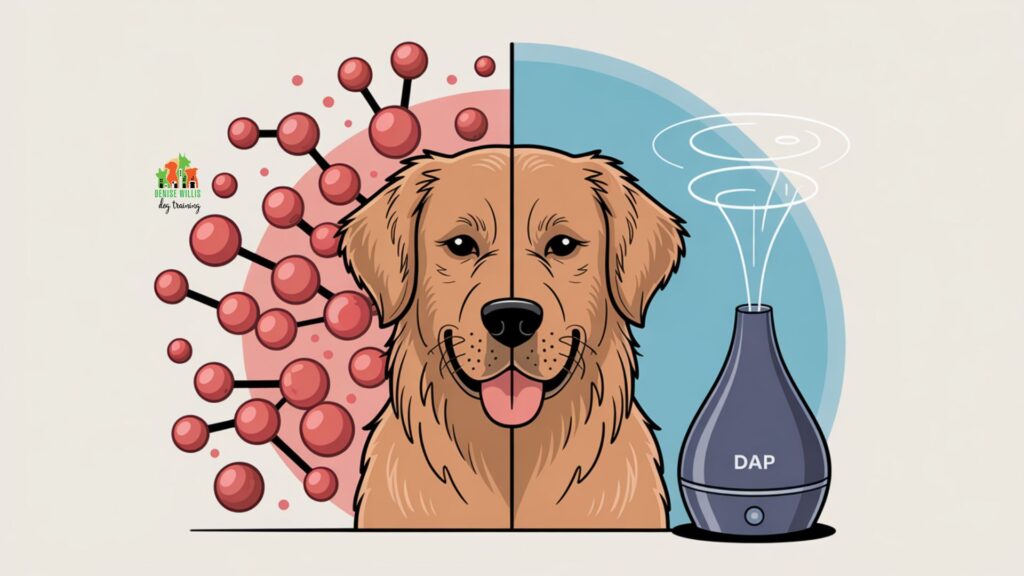
Scent Training: A Therapeutic Approach to Aggression
Harnessing a dog’s natural scenting abilities provides not just mental stimulation but can also serve as effective therapy for dogs with aggressive tendencies. Structured scent activities redirect focus, build confidence, and promote relaxation in ways that directly counteract many of the triggers for aggressive behavior.
Benefits for Reactive Dogs
Nosework and scent detection activities are emerging as powerful therapeutic tools for dogs with reactive or aggressive behaviors. These activities harness a dog’s natural scenting abilities, providing mental stimulation and a positive outlet for their energy, according to Paws Claws Tails. For reactive dogs, scent work offers several key benefits:
- Mental stimulation and focus: Engaging a dog’s brain through scent detection tasks helps channel energy into positive activities rather than reactive behaviors.
- Building confidence: Success in scent detection builds self-esteem, making dogs more resilient in challenging situations.
- Reduction of anxiety: The act of sniffing has a naturally soothing effect on dogs, potentially reducing anxiety levels that often underlie aggressive responses.
A compelling case study from ScentWorkU describes a dog-aggressive Doberman named Zeus who showed remarkable improvement after beginning scent work. Despite severe aggression toward other dogs, Zeus was able to participate in scent classes (with careful management) and showed immediate positive changes: “The change in Zeus was practically immediate. He loved playing the game at home. His eyes would sparkle when we would get ready for class. He napped more and just seemed more at-ease,” according to their blog post.
What makes scent work particularly effective for aggressive dogs is that it can initially be practiced in isolation, allowing the dog to build skills and confidence without the stress of triggers present. As the dog becomes more engaged with and focused on the scenting task, the activity can gradually be practiced in increasingly challenging environments, creating a positive association with situations that might have previously triggered aggression.
Scientific Evidence for Behavioral Improvement
Recent scientific research supports the anecdotal evidence of scent work’s benefits. A study by Aberystwyth University found that dogs trained to detect specific scents showed improved cognitive function and better ability to control their impulses compared to dogs without scent training, as reported by Phys.org.
The researchers tested dogs on tasks requiring inhibitory control, such as navigating around a transparent barrier to reach food and switching their choice based on where food was placed. Dogs with scent training performed significantly better on these tasks, demonstrating enhanced problem-solving abilities and impulse control.
This research has important implications for managing aggression, as poor impulse control is often associated with unwanted behaviors, including aggression. As Dr. Sarah Dalesman from Aberystwyth University noted, “This research shows that dogs that train primarily in scent work have stronger inhibitory control, suggesting that this training can have a positive effect on their behavior.”
The neurological mechanism behind this improvement appears to be related to how scent training engages different neural pathways than visual training. The olfactory bulb connects directly to the limbic system, including areas involved in emotional regulation. Regular scent work exercises these neural connections, potentially strengthening a dog’s ability to process and respond appropriately to environmental stimuli rather than reacting aggressively.
Environmental Management of Scent Triggers
Managing a dog’s environment to reduce exposure to problematic scent triggers represents a pragmatic approach to preventing aggressive episodes. This strategy acknowledges that while behavioral training is essential, sometimes avoiding or controlling exposure to triggers provides immediate relief while longer-term training progresses.
Understanding how environmental factors can trigger aggression through scent is crucial for effective management. Dogs may react aggressively to certain smells that humans cannot detect, and these reactions are influenced by a complex interplay of genetics, early life experiences, and current environmental conditions. At our practice, we’ve observed these patterns consistently in our work with reactive dogs.
Early socialization plays a vital role in determining how dogs respond to scent triggers. Research indicates that dogs who missed proper socialization during their critical period (4-14 weeks of age) are more likely to develop fear-based aggression later in life. This fear may manifest as aggressive responses to unfamiliar scents or environments.
Managing environmental triggers involves identifying specific scents that may provoke aggressive responses and either gradually desensitizing the dog to these stimuli or modifying the environment to reduce exposure. This approach, combined with other techniques such as pheromone therapy and scent training, offers a comprehensive strategy for addressing scent-triggered aggression.
For pet owners, practical environmental management might include:
- Routine cleaning: Regular cleaning of areas where other dogs have marked can reduce territorial triggers.
- Controlled introductions: Introducing new pets gradually using scent-swapping techniques before face-to-face meetings.
- Safe spaces: Creating zones in the home free from competing animal odors where anxious dogs can retreat.
- Scent barriers: Using natural or commercial products to create olfactory boundaries in multi-pet households.
These practical measures provide immediate management while more comprehensive behavioral modification programs take effect. The goal isn’t to permanently isolate the dog from all triggers but to create controlled exposure that builds tolerance over time.
Practical Applications for Dog Owners
Putting scientific knowledge into practice requires accessible, everyday strategies that dog owners can implement. While some cases of scent-triggered aggression require professional intervention, many situations can be improved through thoughtful management and training approaches that any dedicated owner can learn.
DIY Strategies for Managing Scent-Triggered Aggression
For dog owners facing challenges with scent-triggered aggression, several evidence-based approaches can help manage and improve the situation:
- Scent diaries: Keep track of when and where your dog shows signs of aggression, looking for patterns related to particular locations, other animals, or environmental factors.
- Gradual desensitization: Introduce problematic scents in controlled, diluted forms while pairing them with positive experiences like treats or play.
- Counterconditioning: Change your dog’s emotional response to trigger scents by consistently associating them with positive outcomes.
- Enrichment activities: Provide regular opportunities for appropriate sniffing through games like “find it” or scatter feeding that engage your dog’s natural scenting abilities.
- Stress reduction: Implement a consistent daily routine with adequate exercise, mental stimulation, and quiet time to reduce overall anxiety levels.
These approaches acknowledge that while aggression can be frightening for owners, it typically stems from fear, insecurity, or confusion rather than dominance or malice. Addressing the emotional root causes through patient, positive methods yields better long-term results than punishment-based approaches.
When to Seek Professional Help
While many minor cases of scent-triggered reactivity can be managed at home, certain situations warrant professional intervention:
- Sudden onset aggression: Aggression that appears suddenly without clear environmental changes may indicate medical issues requiring veterinary attention.
- Escalating behavior: If aggressive responses are becoming more intense or occurring in more situations despite management efforts.
- Safety concerns: Any situation where human safety or the safety of other animals is at serious risk.
- Plateau in progress: If you’ve implemented management strategies consistently but see little improvement after several weeks.
A qualified professional like a veterinary behaviorist or certified dog behavior consultant can provide a comprehensive assessment, rule out medical contributors, and develop a tailored behavior modification plan that addresses your dog’s specific needs and triggers.
Products and Tools Available for Management
Several commercial products can support a comprehensive approach to managing scent-triggered aggression:
- Pheromone products: DAP diffusers, collars, or sprays that emit synthetic versions of calming pheromones.
- Scent masks: Products designed to neutralize animal odors rather than simply covering them up.
- Enrichment toys: Specialized puzzles and toys that engage scenting abilities while providing mental stimulation.
- Calming supplements: Natural supplements containing ingredients like L-theanine or tryptophan that may reduce overall anxiety levels.
- Training tools: Properly fitted head halters or front-clip harnesses that provide better control during reactive episodes without causing pain or fear.
Remember that these products work best as part of a comprehensive behavior modification program rather than as standalone solutions. The goal is to create an environment where your dog feels secure enough to learn new, more appropriate responses to previously triggering scents.
Product Recommendations
Shopping for a dog with scent-triggered aggression issues is like being a detective in a mystery where your canine companion is the only one who can see the clues. While you’re puzzling over why your pup is suddenly channeling their inner wolverine at seemingly nothing, they’re processing olfactory information you couldn’t detect with a hazmat suit and a microscope.
We’ve sniffed out some products that might help you manage these invisible triggers without needing to develop superhuman smelling abilities.
- ThunderShirt Classic Dog Anxiety Jacket: Wrap your scent-sensitive sidekick in this snug jacket and watch them transform from hyper-alert sentinel to chill companion. It’s like a constant, gentle hug that tells your dog “the suspicious smell of that German Shepherd who walked by six hours ago is NOT a threat to national security.” Warning: May cause your dog to give you that “Why didn’t you buy me this years ago?” look that’s equal parts gratitude and judgment.
- PetSafe Gentle Leader Head Collar: Think of this as GPS navigation for your dog’s attention span when overwhelming scents threaten to hijack your walk. It’s like having a gentle “hey, look at me instead of that fascinating pee-mail from another dog” button. Caution: Your dog may temporarily believe they’ve joined a secret dog society where everyone wears fancy face accessories, and yes, strangers will ask if it’s a muzzle.
- KONG Classic Dog Toy: The Swiss Army knife of dog toys, perfect for redirecting your pup’s focus from triggering scents to something infinitely more entertaining. Stuff it with treats and watch as your dog’s priority shifts from “Must investigate that suspicious odor!” to “Must extract peanut butter from rubber cone!” Warning: Your dog may start expecting you to stuff every meal into this magical red cone of distraction.
- Pet Corrector Spray: When your dog’s nose leads them into reactive behavior, this hissing spray provides an immediate, humane interruption that breaks their focus on the trigger scent. It’s like a olfactory pattern-interrupt that gives you precious seconds to redirect their attention. Caution: The first time you use it, both you and your dog may jump. Consider it a bonding moment of shared surprise.
- Zesty Paws Calming Bites for Dogs: These treats are like yoga class and meditation rolled into one delicious bite, helping take the edge off when scent triggers are unavoidable. With ingredients like chamomile and L-Theanine, they help your dog maintain composure in scent-rich environments. Warning: Your dog might start giving you meaningful looks when you yourself seem stressed, as if to ask “Where’s MY calming treat for dealing with YOU?”
- Treat Pouch: The tactical gear every owner of a scent-reactive dog needs. This pouch keeps high-value treats readily accessible for those crucial moments when you need to compete with an enticing or alarming scent. It’s like carrying around a little bag of “I’m more interesting than that smell” insurance. Caution: May cause you to unconsciously pat your hip even when not with your dog, like a pet parent phantom limb syndrome.
- Outward Hound Nina Ottosson Dog Brick Puzzle Toy: Keep your canine Sherlock Holmes busy with mental stimulation that redirects their scenting abilities toward puzzle-solving instead of trigger-hunting. It’s like “Escape Room: Doggy Edition,” channeling all that olfactory brainpower into a productive outlet. Warning: May turn your dog into a treat-finding savant who starts solving your Sudoku puzzles when you’re not looking.
- Zuke’s Mini Naturals Training Dog Treats: These tiny treats are perfect for rapid-fire reinforcement when working through scent desensitization training. They’re like doggy cryptocurrencies – small, valuable, and your dog will do anything to acquire more. Caution: Your dog may start expecting these for every minor achievement, like successfully ignoring the scent of that suspicious squirrel or heroically refraining from barking at the neighbor’s cat.
Remember, managing a scent-triggered reactive dog is part science, part art, and part comedic improvisation. These products won’t magically transform your olfactory detective into a carefree companion overnight, but they’ll give you both some much-needed support on the journey. And isn’t that what we all need sometimes – a little help navigating a world full of invisible triggers that only some of us can detect?
Further Reading
Think you’ve mastered the mysterious world of canine scent triggers? Think again!
There’s an entire universe of dog behavior science waiting to be explored. We’ve compiled some smell-sational articles to help you dive deeper into understanding what’s going on inside that remarkable noggin of your four-legged friend. Warning: Side effects may include randomly sniffing the air yourself and nodding knowingly.
- Environmental Triggers for Dog Aggression: Discover how the world around your dog might be setting off those aggressive displays. Turns out, your dog isn’t imagining things – that corner of the park really IS sending secret messages through the air! Learn how to identify and manage these invisible environmental tripwires before your dog goes full detective mode.
- Stress-Induced Dog Aggression: Think your dog is just being dramatic? This article uncovers how stress hormones transform your cuddly companion into a reactive mess. Spoiler alert: Those stress chemicals smell different, and other dogs can tell your pup is having a bad day before you even notice. It’s like wearing a “Keep Back: Having Issues” t-shirt that only other dogs can read.
- Decoding Your Dog: 15 Body Language Signals You Need to Know: Ever wish your dog came with subtitles? This guide is the next best thing! Learn to read the subtle “I’m about to lose it because I smell something concerning” signals before the situation escalates. Bonus: You’ll become so fluent in dog-speak that you might catch yourself giving a calming signal to your boss during your next stressful meeting.
- How to Manage Your Dog’s Territorial Aggression: Is your dog treating your front yard like their personal kingdom that must be defended at all costs? This article helps you negotiate peace treaties and establish reasonable borders. Learn why certain scent markers turn your sweet pup into a medieval castle guard and how to help them understand that not every passing dog is planning an invasion.
- 5 Proven Strategies to Stop Your Dog’s Aggression Towards Other Dogs: Transform your canine confrontationalist into a doggy diplomat with these practical strategies. Discover how other dogs’ scent profiles can trigger fight-or-flight responses and how to help your dog make better choices in the face of these powerful signals. Warning: Implementation may result in peaceful walks that leave you wondering what to do with all this newfound stress-free time.
Ready to become the Sherlock Holmes of canine scent detection?
These articles are your magnifying glass, helping you spot the clues your dog has been trying to tell you about all along. Remember, while understanding scent triggers won’t give you your dog’s supernatural nose, it will make you look like a dog-whispering wizard to everyone at the dog park. Just try not to get too smug about it.
Nobody likes a show-off, especially one who keeps talking about “olfactory stimuli” at casual social gatherings.
Frequently Asked Questions About Scent and Dog Aggression
Q: Can dogs really smell my emotions, and can this trigger aggression?
A: Yes, research confirms dogs can detect chemical changes in human sweat during emotional states like fear and anxiety. These stress odors can potentially trigger or intensify aggressive responses in sensitive dogs through a phenomenon called emotional contagion. Maintaining your own calm during tense situations may help prevent escalation of your dog’s reactive behaviors.
Q: Why does my dog become aggressive only in certain environments or locations?
A: Your dog may be reacting to scent markers from other animals that you cannot detect. Locations with high dog traffic contain complex layers of olfactory information that can trigger territorial or fear-based responses. Places where your dog has previously had negative experiences may also contain scent cues that trigger defensive behaviors associated with that memory.
Q: Can neutering/spaying help reduce scent-triggered aggression?
A: While altering your pet reduces hormone-related marking behaviors and may decrease some forms of inter-male aggression, it’s not a cure-all for scent-triggered reactivity. The timing of the procedure matters, with some research suggesting early neutering might actually increase certain fear-based behaviors in some breeds. Discuss the appropriate timing with your veterinarian based on your dog’s specific situation.
Q: Do certain breeds have more issues with scent-triggered aggression?
A: Breed can play a role in how dogs process and respond to scent information. Breeds developed for scent work or hunting (like hounds and sporting breeds) may show more intense responses to certain odors. However, individual temperament, socialization history, and experiences typically have greater influence on aggressive responses than breed alone.
Q: How effective are pheromone products for aggressive dogs?
A: Research shows varying effectiveness depending on the individual dog and the underlying cause of aggression. Pheromone products appear most helpful for fear-based reactivity and may reduce overall stress levels, creating a better foundation for behavior modification. They work best as part of a comprehensive approach rather than a standalone solution.
Test Your Knowledge: Scent Triggers in Dog Aggression
Final Thoughts
The relationship between scent and aggression in dogs reveals the fascinating complexity of canine perception and behavior. Dogs quite literally experience a different world than we do through their remarkable olfactory abilities, detecting layered chemical information that influences their emotional responses and actions. By understanding this connection, we gain valuable insights for managing and reducing aggressive behaviors through targeted interventions.
Effective approaches combine several elements: synthetic pheromones that can modulate hormonal responses related to aggression, scent training that improves cognitive function and impulse control, and environmental management that minimizes exposure to triggers. These methods offer promising, non-invasive alternatives to traditional approaches, addressing root causes rather than simply suppressing symptoms.
At DW Dog Training, we recognize that each dog's aggression stems from unique factors requiring individualized assessment and training plans. Our approach integrates the latest research on scent-triggered behaviors with proven behavior modification techniques to help your dog become calmer, more confident, and better equipped to handle challenging environments.
Share Your Experience
We'd love to hear about your experiences with scent-triggered behaviors in your dog.
Have you noticed specific smells or environments that seem to provoke reactions?
What strategies have you found helpful in managing these situations?
Your insights could help other owners facing similar challenges with their canine companions. Feel free to comment below or reach out directly to share your story and questions.

